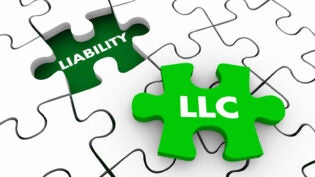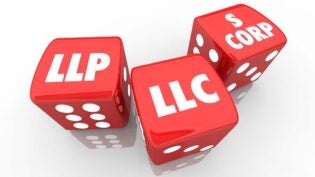
Corporations are treated as separate entities under the law. They generally have the capacity to perform the same types of functions that individuals perform including entering into contracts and promulgating or defending lawsuits. The primary incentive for forming a corporation is to grant limited liability to its owners.
One common misconception among the business community is that by merely filing proper documents with the state, the business owner has established a legally enforceable corporation. However, compliance with formalities is essential in order for the corporation to be granted with the status of limited liability and protect its owners from personal liability. Formalities are especially critical for corporations since they generally contain more rigorous standards than other business entities, such as LLCs.
What Steps Are Required for Establishing a Corporation?
The first step required for establishing a corporation is filing an application for formation (e.g., Articles of Incorporation) with the state. It is generally recommended to establish the corporation in the state in which the business is going to operate. Of course, the corporation can do business in other states provided that the state allows the entity to operate in its state. However, a corporation will be required to file tax returns and pay taxes in any state that mandates state corporate income tax. In addition, different states have different requirements for other forms of compliance (e.g., Statement of Information).
After the state grants permission to the corporation to operate in its state, the next step is to conduct an organizational meeting. This is accomplished by the party that submitted the application for formation. The party that formed the corporation is known as the incorporator. During the organizational meeting, the incorporator appoints the Board of Directors (“Board”).
The next step is for the Board to adopt the Bylaws. The Bylaws are similar to Operating Agreements of LLCs. Bylaws are the heart of the corporation with respect to corporate formalities. They contain information about the annual shareholders meeting, the number of directors the shareholders may appoint, and quorum requirements for shareholder and director meetings. They may also include the various duties the officers may owe to the corporation and even the job descriptions of the officers.
After the Board adopts the Bylaws, the next step is for the Board to appoint the officers of the corporation. California requires for each corporation to have a President, Secretary, and Chief Financial Officer. However, one person may be appointed for all three positions.
Who Are the Owners and Operators of Corporations?
There are generally three categories of actors within corporations: shareholders, directors, and officers. The shareholders own the corporation, while the directors and officers operate it. Since people sometimes misconstrue the different roles of each of these key corporate actors, it is fundamental for anyone who has some form of a nexus with a corporation to understand the standards that apply to each actor based on the particular role.
Shareholders
Similar to living trusts and other business entities, a corporation must be funded or capitalized in order for it to become an enforceable legal entity. Capitalization may occur in the form of money, property, or services performed by a prospective shareholder in return for corporate stock. However, in no event can a shareholder own the corporate assets outright since the assets belong to the corporation. Therefore, the shareholder can only own stock in the corporation itself.
The most common form of capitalization is through a shareholder’s contribution of cash to the corporation. Generally, the Board sell the shares to a shareholder. The shareholder then becomes the owner of the corporation, which in turn grants the shareholder the right to receive dividends in the event the Board makes any distributions.
The Board has other powers besides making distributions to shareholders. The Board may determine not only whether to sell particular stock, but also what type of stock to sell. The type of stock a corporation may sell may vary. Typically, the corporation sells common stock, but in certain instances it may also sell preferred stock.
Common stock grants the same rights and privileges to all of its owners. Common stock grants its owners the right to vote during shareholders’ meetings. It may also grant the shareholders the right to receive dividends based on their pro rata share of ownership; the right to approve fundamental changes, including mergers and dissolutions; and preemptive rights that may prevent dilution of shares since the shareholder has the opportunity to purchase new shares that may allow him to sustain the same percentage of ownership prior to issuance of new shares.
On the other hand, preferred stock is generally a contractual relationship between the corporation and the shareholder. The owner of preferred stock generally has fewer risks than the owner of common stock. The owner of preferred stock may have a right to a specified amount of dividends per annum regardless of whether the Board makes distributions to the owners of common stock. The owner of preferred stock may also have preferential rights in the event of the corporation’s dissolution.
For those corporations that have considerably few shareholders, it is essential for the shareholders to consider forming Shareholders’ Agreements or Buy-Sell Agreements. Buy-Sell Agreements are formed for the specific purpose of determining the aftermath of the shareholder’s shares in the event she divests her interest in the corporation, becomes incapacitated, or dies. Even though both types of agreements are sometimes referred to each other interchangeably, Shareholders’ Agreements generally contain more terms than Buy-Sell Agreements.
These agreements between the shareholders are formed for many reasons; chief among them is to make certain that the shareholder who dies or becomes disabled does not deprive her family members from the right of having a financial stake in her shares. Thus, these agreements set forth the various conditions (e.g., disability and death) that may trigger a buy-out of the shareholder’s shares. If the specified condition occurs, the corporation itself may purchase the shares. In other instances, the shareholders may fund the agreement by purchasing life insurance policies on each other’s lives.
Board of Directors
The shareholders elect the directors at the annual shareholders meeting unless the voting occurs during a special meeting. In California, the Board must include at least three directors unless the corporation has less than three shareholders. If the corporation has two shareholders, only two directors are required. Similarly, if there is only one shareholder, only one director is required.
Directors generally owe fiduciary duties to the corporation, which include the Duty of Loyalty and Duty of Care. However, directors do not have to be in violation of these duties in order for the shareholders to remove them from the Board. The shareholders may potentially remove a director for any reason during a director’s term so long as they provide adequate notice of the special shareholder’s meeting where the removal is contemplated to take place.
There are generally two categories of directors: Inside Directors and Outside Directors. Inside Directors are also usually officers or employees of the corporation. Outside Directors are generally not involved with the operations or executive management of the corporation. Their contribution is strictly limited to their duties as directors or advisors of the corporation.
Directors are accountable for all of the consequential decisions of the corporation. Consequential decisions are those decisions that are likely to have a substantial impact on the corporation. For other types of decisions, the Board may nominate a committee. The committees nominated by the Board can be formed for litigation purposes or when the Board is considering of undertaking major actions, such as large investments. The committees can also be formed for the purpose of complying with an audit or determining the compensation of directors and officers.
Officers
The directors appoint the officers. The officers carry out the decisions that are made by the Board. Typically, positions held by officers may include: President, Vice President, Chief Executive Officer, Chief Financial Officer, Treasurer, and Secretary.
The scope of authority of officers who are in charge of the day-to-day operations of the corporation is limited to the authority provided in the Bylaws and the Board’s potential expansion of the authority so long as there is neither a violation of the Bylaws provisions nor state law. The officer’s scope of authority should also be included in a provision in a contract between the officer and the corporation where the officer’s role is clearly delineated.
What Structures Are Available to Corporations?
There are various types of corporations (e.g., Non-Profit Corporations) available to entities that are looking to establish a particular type of corporation. However, this section focuses on analyzing the following types of corporations: closely held corporations, public corporations, and professional corporations. The alternative to these structures is to operate as an ordinary corporation without being subject to the standards that apply to the particular type of corporation.
Closely Held Corporations
Closely held corporations (“Close Corporations”) are those entities that have few shareholders. There is no public market for the stock of a Close Corporation. In fact, a Close Corporation may have limitations on transfers of its corporate stock from its shareholders to third parties.
California does not permit Close Corporations from having more than 35 shareholders. In order for an entity to qualify as a Close Corporation for IRS purposes, it cannot be a personal services corporation and it cannot have more than five individuals who own 50% or more of the value of its outstanding stock. Certain types of trusts and private foundations may qualify as individuals.
Close Corporations are usually formed in order for the family business to be operated by the family members. Most of the key operational matters of Close Corporations are set forth in the Shareholders’ Agreement. Furthermore, the day-to-day managers and shareholders are generally the same individuals.
The major advantage for forming a Close Corporation is that the formalities that are required for Close Corporations are not as heightened as they are for ordinary corporations. Close Corporations grant the shareholders the ability to operate their business within the terms of the Shareholders’ Agreement in a decentralized fashion. The shareholders may even agree to waive certain formalities such as annual shareholder or director meetings. However, with the advent of LLCs, there is no longer a particular incentive for establishing Close Corporations since LLCs can also provide limited liability and decentralized management structures without being subject to more rigorous formalities.
Public Corporations
A Public Corporation is a corporation which has many shareholders. A corporation will be deemed a Public Corporation within the purview of the Securities and Exchange Commission (“SEC”) if it has more than 750 record shareholders and more than $10 million in assets. While Public Corporations may potentially attract more investors than other types of corporations, the major downside for Public Corporations that are subject to SEC scrutiny is that a corporation’s compliance with SEC regulations is costly. Some examples of compliance include being subject to annual audits and filing quarterly and annual reports.
Professional Corporations
Professional Corporations (“APC”) are corporations that are formed under the laws of a particular state. APCs are formed for the purpose of providing professional services to their customers, patients, or clients. In California, entities that are seeking to qualify as APCs must be comprised of licensed professionals, such as lawyers, dentists, doctors, veterinarians, and certified public accountants. The analogous classification of an APC for IRS purposes is a Personal Service Corporation (“PSC”). The types of entities that may be deemed by the IRS as PSCs are those corporations that provide personal services in specified fields, such as law, accounting, health, or actuarial science.
Similar to non-professionals and other business entities, the primary reason professionals form corporations is limited liability. Professionals, who are also business owners, are subject to the risk of having their personal assets exposed if a lawsuit is promulgated for actions or inactions that occurred during their ordinary course of practice. While malpractice insurance may be a great asset protection tool for mistakes that are made during a professional’s ordinary course of practice, it may not necessarily safeguard the professional’s personal assets if a customer brings a lawsuit after being injured on the premises in which the professional’s business is operated.
Finally, under TCJA, the same entity that is an APC (formed in California) and PSC (deemed by the IRS), with a subchapter C status, must pay a 21% flat tax on its corporate earnings in addition to the $800 annual fee required by the California Franchise Tax Board. Additionally, the dividends may be subject to a 23.8% capital gain tax for non-corporate taxpayers. However, the corporation may instead make a subchapter S election, in which case it will be treated as a pass-through entity and the flat tax will generally not apply at the corporate level.
What Classifications Are Available to Corporations for Tax Purposes?
By default, a corporation is treated as a subchapter C corporation by the IRS. The primary difference between a C corporation and a subchapter S corporation is that a C corporation is taxed on its earnings twice, whereas an S corporation is generally taxed on its earnings once. Subject to certain limitations, any corporation may potentially make an “S” election and be taxed as an S corporation.
C Corporations
The earnings of C corporations are taxed to both the corporation and the shareholder. When the C corporation earns its profits, the profits are taxed on the corporate income. If the corporation makes distributions, the shareholders are also taxed on the profits. This concept is otherwise known as “double-taxation.”
To illustrate how double-taxation works in practice, suppose that the corporation earns $100,000 from selling skin products. First, the corporation pays 21% tax on the $100,000 amount, which nets the corporation in the amount of $79,000. If the corporation makes a distribution of the entire amount to the shareholder who owns 100% of its stock, the shareholder may also pay 23.8% capital gain tax on the $79,000 amount, which amounts to $18,802. In essence, $39,802 ($21,000+$18,802) of the $100,000 amount of the corporate earnings may potentially belong to the federal government.
S Corporations
Similar to partnerships and sole proprietorships, S corporations are pass-through entities. Unlike C corporations, S corporations are not taxed on their corporate earnings. Instead, the earnings and expenses pass through to each shareholder and each shareholder is taxed based on the pro rata share of ownership in the corporation.
Suppose that the same corporation which sells skin products makes a timely election and it is now taxed as an S corporation. The shareholder of the corporation still owns 100% of its corporate stock. The shareholder’s effective tax rate is 18.29%. Since it is an S corporation, the $100,000 amount of the corporate earnings are not taxed at the corporate level. Instead, the income will pass through to the shareholder who may pay 18.29% tax, which amounts to $18,290. Compare $18,290 with the $39,802 amount of tax the same shareholder would ultimately pay if the corporation had not made the S election.
Have a question for tax advantaged structuring of a company?
Contact Haik Chilaryan.
Author: Haik Chilingaryan is the founder and principal of Chilingaryan Law. He is an attorney, entrepreneur, published author, and commentator on TV.
Mr. Chilingaryan has performed extensive research on Like-Kind Exchanges and has been published in the “Mertens Law of Federal Income Taxation.” In addition to Mertens, he has contributed to “Tax Facts Q&As” with research on spendthrift trusts, domestic asset protection trusts, and health care trusts. He has also been the keynote speaker of the “Estate Planning For The Modern Family” seminar, where his presentations covered a wide range of topics from tax planning to asset protection.












